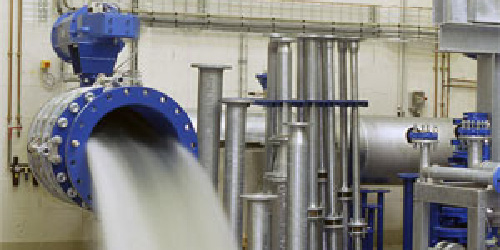What Watergy Involves

What Watergy Involves
Cost-Effective Municipal Water Efficiency Stretches Scarce Water Resources and Tight Budgets
The term Watergy™ was coined by the Alliance to Save Energy to describe the strong link between water and energy in municipal water systems. The approach helps cities realize significant energy, water and monetary savings through technical and managerial improvements in water supply systems, providing consumers with quality water while using a minimum of water and energy.
Abundant Opportunities with Rapid Rates of Return
Watergy efficiency measures repay themselves quickly and the resulting savings in money and water reap many rewards: immediate improvements in water service, increased water delivery, reduced water and energy consumption, and more revenue for system upgrades and new customer connections. Opportunities abound throughout all stages of a water supply system. The most promising areas for intervention are fourfold:
- improving the pumping system,
- managing leaks,
- automating system operations, and
- regular monitoring (preferably including metering of end use).
These improvements often pay for themselves in months, most do so within a year, and almost all recover their costs within three years. Rates of return depend on local conditions, but approximate payback periods for illustrative Watergy measures are as follows:
Immediate to Several Months
- Optimizing electric installation power factors
- Improving operations and maintenance (O&M) procedures
- Pressure management (where high leakage rates occur)
1 – 2 Years
- Metering
- Using automated controls to shift demand away from peak electricity rate periods
2-3 Years
- Installing a new automation system or variable speed drive, or a new energy efficient pump or motor
What Does a Watergy Program Involve?
In many cities most of the inefficiencies occur before the water even reaches the secondary distribution network and end users, making the bulk water supply system the most appropriate focus. The pumping system is all important, since every liter of water that passes through the system represents a significant energy cost, a cost that is magnified by every liter lost to leaks. Pumping improvements range from lower cost measures like soft starters for motors, trimming impellers (when pumps are over-sized) and re-winding motors, to higher cost measures like replacing inefficient pumps with efficient ones and installing variable speed drives. System automation saves water, energy and operation costs, improves service, and lengthens equipment life. Automation handles operational functions in real time in response to changing situations. Examples are optimizing pressure in the network, triggering alarms in case of emergency, turning off pumps, and scheduling reservoir filling to coincide with low electricity rates or low water demand.
Regular monitoring of the system components, operations, and performance is essential to reaching efficiency goals. For example, measuring water flow when demand is lowest at night—and doing so for different sectors of the network—reveals how leaky different sectors are. Monitoring is conducted according to a carefully designed protocol that regularly tracks performance and evaluates it against a set of benchmarks and targets. It should be part of the larger O&M protocol, with regular measurements made on the pump system, motors, and electrical system. A monitoring system rigorously followed by facility staff is a no- or low-cost efficiency enhancement within reach of all utility budgets.
Metering and leak management are improvements that impact the entire system: bulk supply, the distribution system, and end use. Although water utilities can make many efficiency measures in the absence of metering, accurate measurement of end use is a proven, costeffective way to change wasteful consumer behavior and alert the utility to leakage. Last, but certainly not least, effective management of leaks can save enormous quantities of water and energy. Leakage rates can be lowered dramatically with automated controls that reduce pressure in the network, especially at night. Aside from a major pipe break, this pressure management is generally more cost-effective than expensive repairs to numerous leaks in buried pipes. In certain circumstances, however, repairing numerous small leaks yield a rapid return on investment. For example, large quantities of the water pumped to previous townships in South Africa are lost directly through delapidated plumbing fixtures (mainly toilets). In such cases the large scale replacement or repair of household fixtures may be one of the most fruitful Watergy interventions.
Making Watergy Work
After facilitating Watergy is over 40 cities around the world, the Alliance has found that lasting water supply improvements require the following steps before the efficiency measures themselves are implemented:
- Senior management with authority over the local water supply system must have thepolitical will to drive change and to see that the improvements are institutionalized as a new way of doing business.
- Community outreach and education is essential for those projects that will encounter public opposition or where public cooperation is needed.
- A cost-benefit analysis must be conducted by a reputable service provider so the various intervention options and their approximate payback periods are understood. This analysis can be in the form of an audit or a feasibility study.
With this foundation, the Watergy improvements that follow will provide the municipality with lasting savings in energy, water and money for years to come.
STAY EMPOWERED
Help the Alliance advocate for policies to use energy more efficiently – supporting job creation, reduced emissions, and lower costs. Contact your member of Congress.
Energy efficiency is smart, nonpartisan, and practical. So are we. Our strength comes from an unparalleled group of Alliance Associates working collaboratively under the Alliance umbrella to pave the way for energy efficiency gains.
The power of efficiency is in your hands. Supporting the Alliance means supporting a vision for using energy more productively to achieve economic growth, a cleaner environment, and greater energy security, affordability, and reliability.



